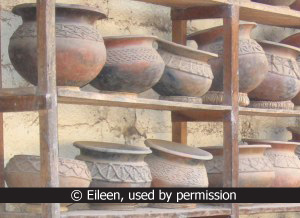A few years ago, I got to experience a different kind of classroom. I sat in a large sun-filled studio for my first-ever lesson in pottery making. After throwing my clay into the center of the wheel and molding it into a cone shape, I waited with my hands poised, listening to the instructor explain how to start the wheel. “You’re going to find that the clay wants to spin off the wheel,” she said, “but it has to stay right there in the center.”
 Sure enough. Only a few seconds after I started my wheel, I realized my clay had a mind of its own. I was trying to focus on pressing the cone tip down to become the base of my pot, but my lump of clay seemed intent on sliding out from under my hands. Two or three times in the process of forming the pot, I felt that obstinate clay go slightly airborne, inching its way off the wheel, and I had to exert extra pressure to bring it back. Why does clay act that way?
Sure enough. Only a few seconds after I started my wheel, I realized my clay had a mind of its own. I was trying to focus on pressing the cone tip down to become the base of my pot, but my lump of clay seemed intent on sliding out from under my hands. Two or three times in the process of forming the pot, I felt that obstinate clay go slightly airborne, inching its way off the wheel, and I had to exert extra pressure to bring it back. Why does clay act that way?
Granted, I lacked skill as a potter and really had no idea what I was doing, so the fault was probably mine. But I couldn’t help noting the spiritual analogy and pondering it for days after I left the pottery classroom. Why do I act like that clay when I’m on God’s wheel? Why do I try to maneuver myself out of the “molding” situations His providence puts me in for my own good? Why do I inch away from His hands when He points out a sin I need to confess? Why do I often try to “slide out from under” His loving work of making me more like Christ?
I guess the process of pottery making is anything but comfortable for the clay. But if only that recalcitrant lump could see the beautiful vision of what the Potter has for it, the last thing it would want to do is “spin off the wheel.” It would draw a figurative breath of joyful wonder and say, “Have Thine own way, Lord! . . . Mold me and make me after Thy will, while I am waiting, yielded and still.”
Reference
Adelaide A. Pollard, “Have Thine Own Way, Lord,” Rejoice Hymns (Greenville, SC: Majesty Music, 2011), 494 (emphasis added).
Leave a Reply